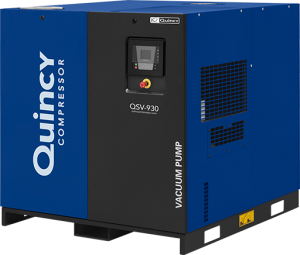Industrial Vacuum Pumps

- Rotary vane: A rotary vane industrial vacuum pump works by positive displacement, which entails the forcing of a fixed amount of fluid from the pump’s inlet pressure section to its discharge, a process that is similar to that of a syringe. Rotary vane pumps are comprised of a series of vanes that are mounted to a rotor that turns inside a cavity. As the vanes rotate, centrifugal force extends them from their individual slots, forming compression cells. Learn more about finding the right parts for your rotary vane vacuum pump
- Articulated piston: An articulated piston industrial vacuum pump operates in a manner similar to that of an automobile engine. As the piston moves downward inside the cylinder, air is drawn in through the intake valve. During the piston’s upward stroke, the air is permitted to escape via an exhaust valve. Two spring-backed piston rings are used to seal the piston to the cylinder.
- Screw: Rotary screw pumps include two parallel rotary screws in the pump housing. The screws are synchronized to turn in opposite directions, which causes the compression action to occur. The gas is compressed in the direction of the pump’s discharge port. Pump cooling occurs via a water-cooled outer chamber. A major advantage of screw industrial vacuum pumps is that they require no lubrication in the pumping chamber, which eliminates contamination and pollution.
- Liquid ring: Liquid ring pumps also operate via positive displacement. During operation, the pump’s impeller rotates inside the pump casing. A rotating liquid ring then seals the impeller and its blades. Liquid is sucked into the compression chamber to keep the ring stable. Conveyed gas is compressed during each impeller revolution.
- Claw: Claw vacuum pumps consist of two rotors that do not come in contact with one another during rotation. As the rotors turn, gas moves from the suction side to the pressure side, where the difference in pressure between the two sides causes the gas to be compressed. Cooling air is drawn into the compression housing to reduce the temperature before it exits the pump.

